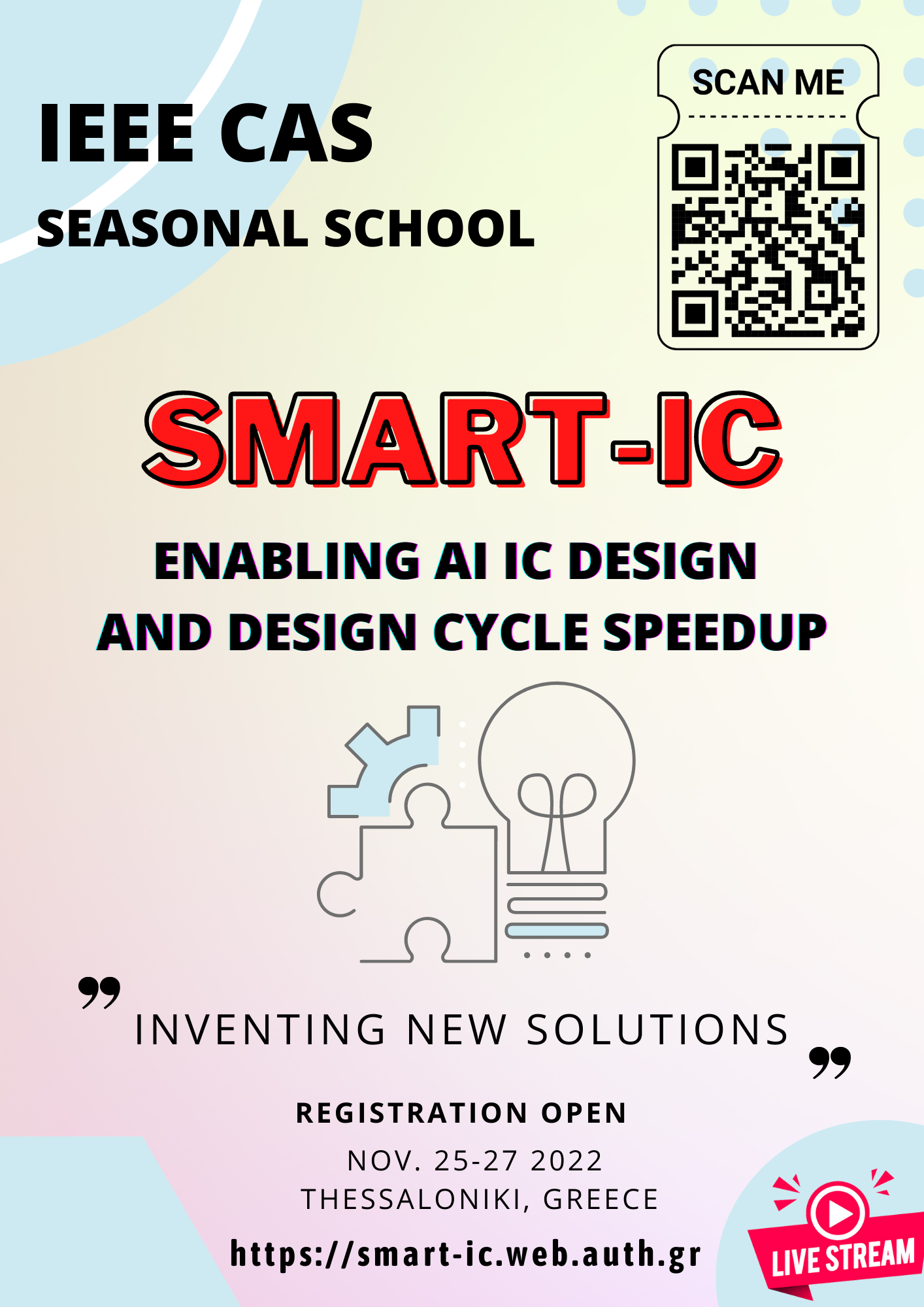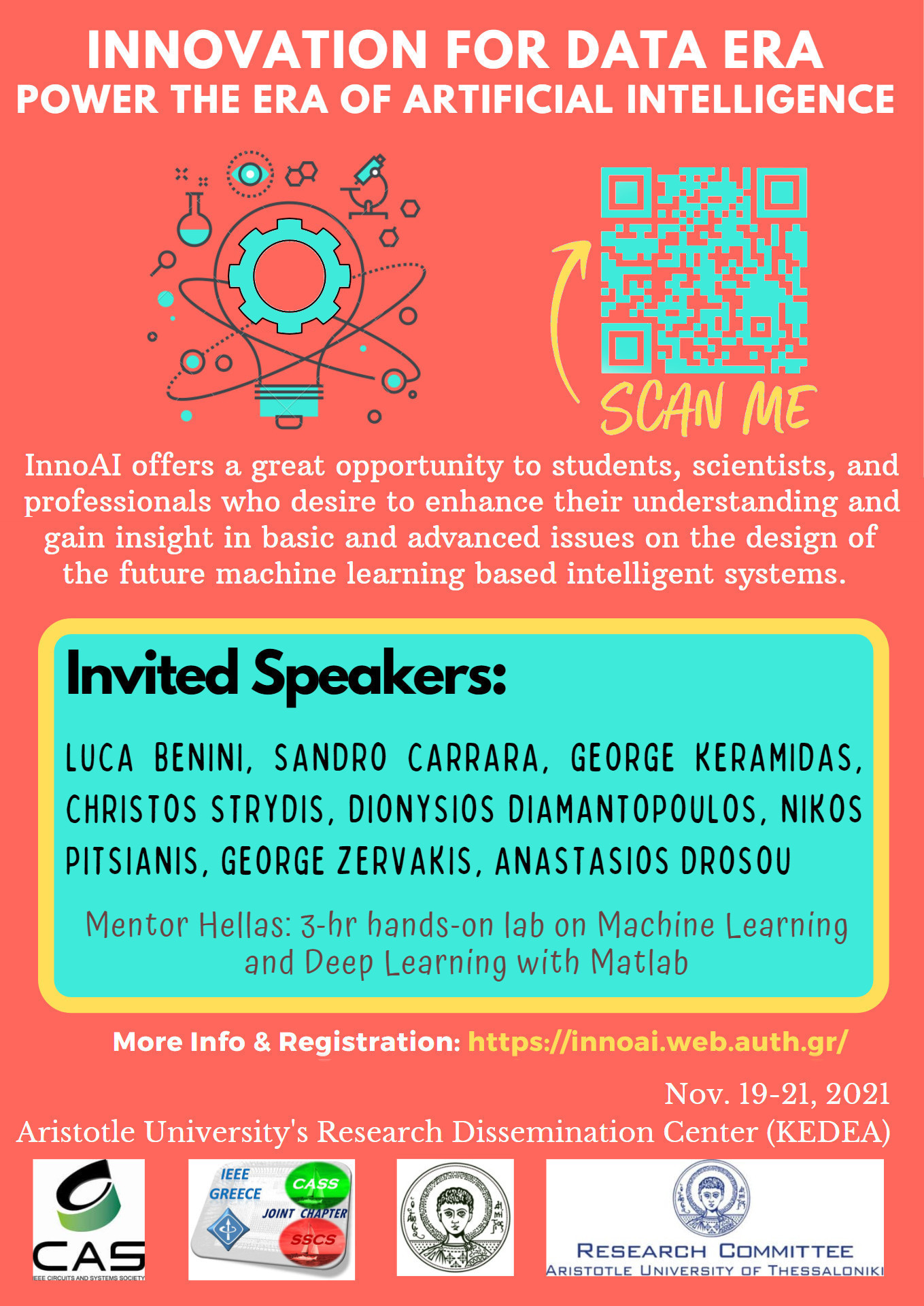Recent News
Now
Our submission “Evolutionary Approximation of Ternary Neurons for On-sensor Printed Neural Networks”, a collaboration with Chair for Embedded Systems (CES) at the Karlsruhe Institute of Technology (KIT), University of Michigan, Brno University of Technology and University of Patras (Greece), is accepted in International Conference on Computer-Aided Design (ICCAD), Oct. 2024, New Jersey, USA.
Our submission “FEARLESS: a Federated Reinforcement Learning Orchestrator for Serverless Edge Swarms”, a collaboration with School of ECE, National Technical University of Athens is accepted in IEEE Embedded Systems Letters, 2024.
Our submission “Heterogeneous Accelerator Design for Multi-DNN Workloads via Heuristic Optimization”, a collaboration with Karlsruhe Institute of Technology (KIT) is accepted in IEEE Embedded Systems Letters, 2024.
Our submission “Hardware-Aware DNN Compression via Diverse Pruning and Mixed-Precision Quantization”, a collaboration with Chair for Embedded Systems (CES), at the Karlsruhe Institute of Technology (KIT) and Southern Illinois University is accepted in IEEE Transactions on Emerging Topics in Computing, 2023.
Smart-Plant: Technologies for Smart Agriculture in the IoT Era
IEEE CAS Seasonal School
10-11 December 2023
Details: https://smart-plant.physics.auth.gr/
Our submission “Bespoke Approximation of Multiplication-Accumulation and Activation Targeting Printed Multilayer Perceptrons”, a collaboration with Karlsruhe Institute of Technology (KIT) and University of Patras (Greece) is accepted in International Conference on Computer-Aided Design (ICCAD), 2023, San Francisco, USA.
Our submission “Online Energy Management Framework for Smart Buildings with Low-Complexity Estimators”, a collaboration with IMEC v.z.w. (Belgium) and Osaka University (Japan) is accepted in IEEE Embedded Systems Letters.
Our submission “Hardware-Aware Automated Neural Minimization for Printed Multilayer Perceptrons”, a collaboration with Karlsruhe Institute of Technology (KIT) and University of Patras (Greece) is accepted in Design, Automation and Test in Europe (DATE’23) conference.
Our submission “The SERRANO platform: Stepping towards seamless application development & deployment in the heterogeneous edge-cloud continuum”, a collaboration within the SERRANO H2020 project is accepted in Design, Automation and Test in Europe (DATE’23) conference.
Our submission “Dynamic Heap Management in High-Level Synthesis for Many-Accelerator Architectures”, a collaboration with IBM Zurich Research Laboratory is accepted in International Conference on Field Programmable Logic & Applications (FPL) 2022.
Our submission “AdaPT: Fast Emulation of Approximate DNN Accelerators in PyTorch“, a collaboration with Chair for Embedded Systems (CES), at the Karlsruhe Institute of Technology (KIT), is accepted in IEEE Transactions on Computer-Aided Design of Integrated Circuits and Systems, 2022
Our submission, “Dynamic Optimization of On-Chip Memories for HLS Targeting Many-Accelerator Platforms”, a collaboration with IBM Zurich Research Laboratory is accepted to IEEE Computer Architecture Letters, vol. 21, no. 2, pp. 41-44, 1 July-Dec. 2022
Our submission, “Dynamic Heap Management in High-Level Synthesis for Many-Accelerator Architectures“, a collaboration with IBM Zurich Research Laboratory is accepted to International Conference on Field-Programmable Logic and Applications (FPL) 2022.
Our submission, “Variability-Aware Approximate Circuit Synthesis via Genetic Optimization“, a collaboration with Chair for Embedded Systems (CES), at the Karlsruhe Institute of Technology (KIT), is accepted to IEEE Transactions on Circuits and Systems I: Regular Papers.
Our submission, “Wide-range light harvesting module for autonomous sensor nodes” is accepted to IEEE Access, 2022, doi: 10.1109/ACCESS.2022.3161486.
Our submission, “Design of a 10-Bit, 2GS/S Current-Steering Digital-to-Analog Converter with On-Line Current Calibration” is accepted to IEEE International Symposium on Circuits & Systems (ISCAS), 2022.
Our submission, Automated Design Approximation to Overcome Circuit Aging, a collaboration with Chair for Embedded Systems (CES), at the Karlsruhe Institute of Technology (KIT), is accepted to IEEE Transactions on Circuits and Systems I: Regular Papers.
SERRANO H2020 Project

SERRANO: Transparent Application Deployment In a Secure, Accelerated and Cognitive Cloud Continuum project, is accepted for funding at ICT-40-2020 Cloud Computing: towards a smart cloud computing continuum.
We are witnessing a wave of emerging cloud computing technologies and services that empower advanced applications from different vertical sectors, with diverse requirements. In addition, there is a movement from top-down-designed architectures that apply centralized resource control, towards federations of loosely coupled autonomous or semi-autonomous systems, managed by multiple independent actors that are self-organized in a distributed manner. These trends give rise to a number of fundamental challenges that relate to the application deployment, the support of heterogeneous infrastructures and the provided security. Inline with the above, SERRANO steps in to define an intent-based paradigm of operating federated infrastructures consisting of edge, cloud and HPC resources, which will be realized through the SERRANO platform. At the top, SERRANO will create an abstraction layer that automates the process of application deploying functionality across the various computing technologies. This layer will be part of an infrastructure agnostic automation process that translates applications’ high-level requirements to infrastructure-aware configuration parameters. The SERRANO platform will automatically determine the most appropriate (computing, storage, networking) resources of the cloud continuum to be used by an application, and then transparently deploy workloads and coordinate data movement. A sense, discern, infer, decide, and act, continuous control loop will run over an infinite to adjust resources and migrate the tasks based on feedback regarding the application’s and the resources’ state. Service assurance mechanisms based on artificial intelligence and machine learning techniques will facilitate the autonomous adaptation and management of the deployed services and resources. These mechanisms will be dynamically triggered by a data-driven cloud and network telemetry framework that collects and analyses telemetry data across the distributed edge/cloud/HPC infrastructure. SERRANO platform will also develop hardware and software-based mechanisms that provide security, privacy and multi-tenancy by design. In this way, applications and users will be able to maintain control over their data integrity and privacy when relying on publicly shared edge and cloud infrastructures. SERRANO will capitalize on the benefits offered by hardware accelerators used to execute prototype tasks that arise often in applications, coupled with novel transprecision computing mechanisms to exploit the accuracy versus resource usage tradeoff. These will enable the dynamic adaptation of the computations’ precision, based on application requirements, further improving the overall performance and energy efficiency of the infrastructures. Finally, SERRANO will demonstrate its advanced and innovative capabilities through three well-defined use cases in cloud storage services, fintech and manufacturing, utilizing edge, cloud and HPC infrastructures. The use cases correspond to high-demanding, safety-critical, dynamic, greatly impactful applications that pose heterogeneous demands.
Our submission, Thermal Comfort Aware Online Energy Management Framework for a Smart Residential Building, a collaboration with Osaka University, IMEC, and National Technical University of Athens, is accepted to Design, Automation and Testing in Europe (DATE’21) conference.
Our submission, Rapid Prototyping of Low-Complexity Orchestrator Targeting CyberPhysical Systems: The Smart-Thermostat Usecase, a collaboration with National Technical University of Athens, is accepted at the IEEE Transactions on Control Systems Technology.
SMARTBEEING Project

SMARTBEEING: Bee population health, wellbeing and yield improvement through novel monitoring technologies project, is accepted for funding.
Beekeeping comprises one of the most important fields of primary production of our country. According to data from the Ministry of Rural Development and Food, about 23,000 beekeepers are employed in the beekeeping sector, holding about 1,568,000 hives. In addition, recent studies show that Greece comes second in the European Union after Spain, regarding colonies, producing by average 14,000 tons of honey per year.
Despite its importance and benefits, beekeeping is one of the most demanding primary production sectors. The degree of difficulty lies in the fact that in most cases beekeepers are engaged in nomadic beekeeping and are forced to move their hives several kilometers away to carry out a typical short-term inspection. The research proposal “SMARTBEEing” introduces the design, development and pilot application of an innovative system of early-warning and avoiding a set of stressful factors – situations that are directly related to the bee’s “social” life and to the quality of the final products. In this context, ICT-supported methodologies will be developed for (a) support of beekeeping management and estimation of possible stressful situations, (b) real-time hive tracking in field conditions from distance and (c) support decision-making through appropriate data analysis mechanisms.
Contrary to the existing approaches that primarily aim at recording parameters (eg weight), the proposed solution also allows for the accurate assessment of future adverse situations (eg swarming, loss of queen) and the implementation of appropriate corrective actions by beekeepers. The aim of the “SMARTBEEing” project is to create an integrated hive-based system in a hive level, in a beekeeper level and globally. A set of parameters regarding the honeybee colony itself and its location will be taken into account, while the product will be characterized by low acquisition / maintenance costs and a friendly interface with the not-familiar with the technology end-user, in order to be further commercially exploited. The “SMARTBEEing” approach involves the instrumentation of low-cost electronic equipment in hives, where in combination with appropriate outcome models and the supporting software developed within the project, will allow: (a) timely notification of upcoming swarming, abandoning of colony and the presence or not of the queen in the hive, (b) managing the internal conditions of the hive in order to prevent diseases, (c) estimating the future productivity of bees and (d) increasing security against theft and natural enemies of bees. The system estimates will provide the beekeeper with the time to respond with the proposed managements.
After the development and calibration of the system by the research entities, the confirmation of the “SMARTBEEing” evaluation will be carried out by a group of beekeepers under the supervision of the Laboratory of Apiculture-Sericulture (AUTH) and the School of Physics (AUTH). The necessary preparation for mass production of the device will be made by the ENIA3 company. Both the installation of the system and its pilot application will allow the design of a business plan for the successful expansion and commercial exploitation of the proposed system, linking research and innovation to entrepreneurship.
ICE Project

ICE: Innovative Cultural Experience project, is accepted for funding.
This proposal aims to develop an innovative product named Innovative Cultural Experience (ICE), which combines the following cutting-edge technologies: 1. Transparent Window – touch screen, interactive technology, 2. Augmented Reality, monuments-exhibits, 3D immersive video, intangible heritage narration. The product will provide a unique atomic or mass-touring experience, utilizing information based on material and intangible cultural heritage, through narrative scenarios. ICE will be a Transparent Window’s advanced state of the art, in which any exhibit that will enter it will be able to display visually enhanced and augmented Reality information to the user/visitor (admin enabled). In addition, visitors can, using the built-in 3D Camera, upload their own Video with their views or impressions from the exhibit.
Relevant video and audio files will be downloaded to the specific aggregate content aggregator, developed for the purposes of the proposal. For best viewing experience, the user will be given the opportunity to watch three-dimensional video stretching, especially when the exhibit is in open space. In this way the visitor benefits from the passage to the active and experiential tour/promotion of a cultural or commercial product, utilizing the modern pedagogical norms of “bodystorming” of “brainstorming” and “narrative”. The proposed approach is particularly meaningful in the case of educational actions, where brainstorming and the development of bodystorming are of the utmost importance for the exploitation of educational experiences and the recording of end-user preferences/impressions-consumers. The advantage of ICE is based on the collection of alternative multimedia sources of information (material – immaterial), and it can adopt alternative forms of presentation of the aggregated information. ICE is cognitively neutral (domain independent) technology, which makes it useful for a variety of thematic items (from museum exhibits to folk customs, local recipes, etc.).
Its technological implementation will focus on the cultural heritage of Eastern Macedonia and Thrace with the emergence of specific cultural monuments of the three religious’ traditions of the region (Christian, Muslim and Hebrew) and their associated narratives as an intangible cultural heritage manifestation. For the platform 1. will be selected and systematized the existing historical and archaeological records, accessible by multimedia materials; 2. research will be carried out and photographic recordings will be accomplished with a 3D Video integration of monuments and sound narratives as well as multimedia representations, showing the rich religious testimony in the area; 3. Oral narratives by the local population about the monuments will be collected and recorded, utilizing the experience and outcomes from a previous NSRF Operational Program 2007-2 013, entitled “Education and Lifelong Learning Programs of Theologians and Priests of Thrace on Religious, Religious and Intercultural Religious Education”. The electronic platform beyond the Greek language will be translated into English and Turkish, will be implemented with interdisciplinary and appropriate technology and will allow for exploitation and enrichment with additional elements and languages.
ICE will be linked to the XENAGOS platform, three demo cases will be developed on how to use ICE in terms of promoting culture, education, commercial and tourist product development.
Our submission, Multi-user IFoF uplink transmission over a 32-element 60GHz phased array antenna enabling both Frequency and Spatial Division Multiplexing, is accepted to European Conference on Optical Communication (ECOC’19).
Our submission, VADER: Voltage-Driven Netlist Pruning for Cross-Layer Approximate Arithmetic Circuits, is accepted at the IEEE Transactions on Very Large Scale Integration (VLSI) Systems.
Our submission, Optimizing SVM Classifier Through Approximate and High Level Synthesis Techniques, is accepted to International Conference on Modern Circuits and Systems Technologies (MOCAST’19).
Our submission, ECG Analysis and Heartbeat Classification Based on Shallow Neural Networks, is accepted to International Conference on Modern Circuits and Systems Technologies (MOCAST’19).
Our submission, A Design Flow Framework for Fully-Connected Neural Networks Rapid Prototyping, is accepted to International Conference on Omni-Layer Intelligent Systems (COINS’19).
Our submission, A Low-Complexity Framework for Distributed Energy Market Targeting Smart-Grid, is accepted to Design, Automation and Testing in Europe (DATE’19) conference.
Our new Book entitled “IoT for Smart Grids: Design Challenges and Paradigms” is available from Springer International Publishing.
Our submission, OpenCL-based Virtual Prototyping and Simulation of Many-Accelerator Architectures, a collaboration with Karlsruhe Institute of Technology and National Technical University of Athens, is accepted at the ACM Transactions on Embedded Computing Systems (TECS).
Our submission, Towards plug&play Smart Thermostats inspired by Reinforcement Learning, a collaboration with National Technical University of Athens, is accepted to Workshop on INTelligent Embedded Systems Architectures and Applications (INTESA’18).
EDBM34 Project

EDBM34 project Automated methodology for production and execution of data-centric multi-level approximate equivalent applications for heterogeneous computing platforms, is accepted for funding.
Ένα μείζον ζήτημα που καλείται να αντιμετωπίσει η επιστήμη των υπολογιστών στην σύγχρονη εποχή είναι η επιτάχυνση των εφαρμογών υπολογιστικού νέφους με ταυτόχρονη μείωση της απαιτούμενης καταναλισκόμενης ενέργειας για την εκτέλεση αυτών. Για το λόγο αυτό, η βιομηχανική και επιστημονική κοινότητα έχει στραφεί στην μελέτη και χρησιμοποίηση εναλλακτικών αρχιτεκτονικών και τεχνικών υπολογισμού. Πρόσφατα, μεγάλο ενδιαφέρον έχει προσεγγίσει η χρησιμοποίηση και διερεύνηση επαναδιαμορφούμενων επιταχυντών υλικού, καθώς επίσης και η τεχνική του προσεγγιστικού υπολογισμού.
Οι επαναδιαμορφούμενοι επιταχυντές υλικού χρησιμοποιούνται πλέον ευρέως για την επιτάχυνση των υπολογιστικά πολύπλοκων συναρτήσεων των εφαρμογών προσφέροντας σημαντική επιτάχυνση στην εκτέλεση της εφαρμογής καθώς και μείωση της καταναλισκομένης ισχύος. Από το 2010 και μετά, υπάρχει μια έξαρση στην έρευνα που διεξάγεται στον τομέα των τεχνικών του προσεγγιστικού υπολογισμού. Ο προσεγγιστικός υπολογισμός μπορεί να εφαρμοστεί τόσο στο λογισμικό όσο και στο υλικό, και χαλαρώνοντας την ακρίβεια των υπολογισμών (σε αποδεκτά ανά εφαρμογή πλαίσια), προσφέρει εξαιρετικά αποτελέσματα (μεγαλύτερα του 50%) τόσο στην επιτάχυνση όσο και στην μείωση της κατανάλωσης των εφαρμογών και των κυκλωμάτων. Στα πλαίσια της παρούσης ερευνητικής ομάδας, στοχεύοντας στην μόχλευση των δυνατοτήτων και πλεονεκτημάτων των ετερογενών υπολογιστικών αρχιτεκτονικών και του προσεγγιστικού υπολογισμού, προτείνουμε μια αυτοματοποιημένη μεθοδολογία παραγωγής και εκτέλεσης δεδομενο-κεντρικών πολυ-επίπεδων προσεγγιστικών ισοδύναμων εφαρμογών για ετερογενείς πλατφόρμες υπολογισμού. Σε αντίθεση με τις υπάρχουσες μεθοδολογίες στην επιστημονική βιβλιογραφία, η προτεινόμενη μεθοδολογία εφαρμόζει πολύ-επίπεδες προσεγγιστικές τεχνικές. Πιο συγκεκριμένα, στοχεύοντας στην αξιοποίηση των δυνατοτήτων τόσο των προσεγγιστικών τεχνικών σε επίπεδο λογισμικού αλλά και σε επίπεδο υλικού, θα δημιουργηθεί μια βιβλιοθήκη όπου θα συλλεχθούν απ’ την αντίστοιχη βιβλιογραφία οι βέλτιστες, σε κάθε επίπεδο, τεχνικές και θα εφαρμοστούν σε κάθε εφαρμογή, αυτές που αποφέρουν τον καλύτερο συνδυασμό σφάλματος-επιτάχυνσης-μείωση κατανάλωσης ενέργειας. Επίσης, για την περαιτέρω αύξηση της απόδοσης της προτεινόμενης μεθοδολογίας και την επίτευξη καλύτερων λύσεων, δηλαδή ακόμα μεγαλύτερη επιτάχυνση και μείωση της κατανάλωσης, μέσα στα όρια του επιτρεπόμενου σφάλματος, οι προσεγγιστικές τεχνικές που εφαρμόζονται είναι δεδομενο-κεντρικές. Δηλαδή, κατά τη διάρκεια εκτέλεσης της εφαρμογής, για κάθε διαφορετική είσοδο επιλέγονται εκείνες οι προσεγγιστικές τεχνικές που για την συγκεκριμένη είσοδο επιτυγχάνουν τα μεγαλύτερα κέρδη, ικανοποιώντας παράλληλα το όριο σφάλματος που έχει θέσει ο χρήστης. Επιπροσθέτως, κρίσιμο σημείο στην αποτελεσματικότητα της προτεινόμενης μεθοδολογίας είναι ότι εφαρμόζεται αυτοτελώς και αυτοματοποιημένα, απαλλάσσοντας έτσι τον προγραμματιστή από τον αυξημένο φόρτο της σχεδίασης προσεγγιστικών εφαρμογών, ειδικά όταν αυτές απευθύνονται σε ετερογενείς πλατφόρμες υπολογισμού. Η αυτοματοποίηση της μεθοδολογίας επιτυγχάνεται μέσω μιας φάσης εκπαίδευσης η οποία για κάθε εφαρμογή ανιχνεύει τα σημεία που μπορούν να εφαρμοστούν οι προσεγγιστικές τεχνικές και με τη χρησιμοποίηση εκτιμητών και μηχανικής μάθησης μοντελοποιεί τόσο το σφάλμα όσο και τα αντίστοιχα κέρδη της εφαρμογής και μέσω ενός ευρετικού επιλητή βρίσκει τον βέλτιστο συνδυασμό προσεγγιστικών τεχνικών και τελικά παράγει έναν ελεγκτή ο οποίος στη διάρκεια της εκτέλεσης αποφασίζει ποιες προσεγγιστικές τεχνικές θα εφαρμοστούν σε κάθε νέα είσοδο. Η αποτελεσματικότητα της αυτοματοποιημένης μεθοδολογίας θα ποσοτικοποιηθεί με τη χρήση μιας πλατφόρμας αιχμής, η οποία προτείνεται από την εταιρεία Maxeler, και χρησιμοποιεί τόσο συμβατικούς υπολογιστές όσο και πλειάδες επιταχυντών υλικού. Τέλος, λόγω της ετερογένειας της πλατφόρμας υλοποίησης, αλλά και τις ανάγκης για γρήγορη προτυποποίηση και προσομοίωσης της εφαρμογής (κατά τη φάση εκπαίδευσης) εξαιτίας του μεγάλου όγκου των δεδομένων εισόδου και των διαφορετικών προσεγγιστικών τεχνικών και συνδυασμών τους που μπορούν να εφαρμοστούν, θα χρησιμοποιηθεί μια επέκταση της βραβευμένης από την Cadence πλατφόρμας συν-προσομοίωσης υλικού και λογισμικού με το ακρωνύμιο Plug&Chip, η οποία έχει αναπτυχθεί με ιδίους πόρους από μέλη της ερευνητικής ομάδας.
Our submission, A Flexible Decision-Making Mechanism Targeting Smart Thermostats, a collaboration with National Technical University of Athens, is accepted at the IEEE Embedded Systems Letters.
Our new Book entitled “Cyber-Physical Systems: Decision Making Mechanisms and Applications” is available from River Publishers.
Our submission, From Edge To Cloud: Design and Implementation of a Healthcare Internet of Things Infrastructure, a collaboration with National Technical University of Athens, is accepted to International Symposium on Power and Timing Modeling, Optimization and Simulation (PATMOS’17).
Our submission, Algorithmic and memory optimizations on multiple application mapping onto FPGAs, a collaboration with National Technical University of Athens, is accepted to Embedded Computer Systems: Architectures, Modeling, and Simulation (SAMOS’17) conference.
Our submission, On supporting rapid prototyping of embedded systems with reconfigurable architectures, a collaboration with National Technical University of Athens, is accepted at the VLSI Journal.
Our submission, FabSpace 2.0: A platform for application and service development based on Earth Observation data, a collaboration with University of Toulouse III, Corallia Research Center Athena and National Technical University of Athens, is accepted to International Conference on Modern Circuits and Systems Technologies (MOCAST’17).
Our submission, Parameter Sensitivity in Virtual FPGA Architectures, a collaboration with Karlsruhe Institute of Technology and National Technical University of Athens, is accepted to International Symposium on Applied Reconfigurable Computing (ARC’17).
Our submission, A Low-Complexity Control Mechanism Targeting Smart Thermostats, a collaboration with Democritus University of Thrace and National Technical University of Athens, is accepted at the Energy and Buildings Journal.
Our submission, Application Performance Improvement By Exploiting Process Variability On FPGA Devices, a collaboration with National Technical University of Athens, is accepted to Design, Automation and Testing in Europe (DATE’17) conference.
Our submission, A Customizable Framework for Application Implementation onto 3-D FPGAs, a collaboration with National Technical University of Athens, is accepted at the IEEE Transactions on Computer-Aided Design of Integrated Circuits and Systems.
Our submission, A Framework for Interconnection-Aware Domain-Specific Many-Accelerator Synthesis, a collaboration with National Technical University of Athens, is accepted at the ACM Transactions on Embedded Computing Systems (TECS).
Our submission, An Integrated Exploration and Virtual Platform Framework for Many-Accelerator Heterogeneous Systems, a collaboration with National Technical University of Athens, is accepted at the ACM Transactions on Embedded Computing Systems (TECS).
Our submission, An OpenCL-based Framework for Rapid Virtual Prototyping of Heterogeneous Architectures, a collaboration with Karlsruhe Institute of Technology and National Technical University of Athens, is accepted to International Conference on Embedded Computer Systems: Architectures, Modeling and Simulation (SAMOS’16).
Our submission, A Framework for Exploring Alternative Fault-Tolerant Schemes Targeting 3-D Reconfigurable Architectures, a collaboration with Drexel University and National Technical University of Athens, is accepted to International Conference on Embedded Computer Systems: Architectures, Modeling and Simulation (SAMOS’16).
Our submission, ANT3D: Simultaneous Partitioning and Placement for 3-D FPGAs based on Ant Colony Optimization, a collaboration with National Technical University of Athens, is accepted at the IEEE Embedded Systems Letters.
Start working at Department of Physics, Aristotle University of Thessaloniki (AUTH).

